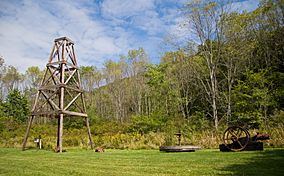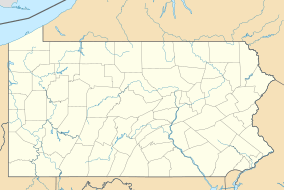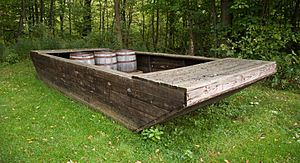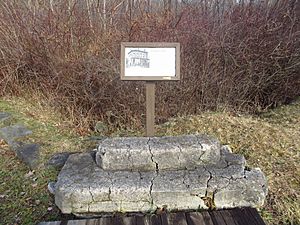Oil Creek State Park facts for kids
Quick facts for kids Oil Creek State Park |
|
|---|---|
|
IUCN Category III (Natural Monument)
|
|

A historic recreation of a wooden oil derrick at Oil Creek State Park
|
|
| Location | Venango, Pennsylvania, United States |
| Area | 6,250 acres (25.3 km2) |
| Elevation | 1,407 ft (429 m) |
| Established | 1931 |
| Governing body | Pennsylvania Department of Conservation and Natural Resources |
| Website | Oil Creek State Park |
Oil Creek State Park is a cool state park in Venango County, Pennsylvania. It covers about 6,250 acres (2,530 ha) of land. The park is right next to the Drake Well Museum. This museum is where the very first successful oil well in the United States was drilled.
The park follows Oil Creek between the towns of Titusville and Oil City. It's located along Pennsylvania Route 8. While the creek is great for fun activities, the park also holds the history of Pennsylvania's early oil industry. You can find old oil boomtown sites here. The park has a museum, displays, and trails to help visitors learn about this important history. There's even a special train ride!
The Pennsylvania Department of Conservation and Natural Resources (DCNR) picked Oil Creek State Park as one of "25 Must-See Pennsylvania State Parks." This means it's a really special place to visit.
Contents
History of Oil Creek State Park
The story of Oil Creek State Park is closely linked to the rise and fall of the oil business in northwestern Pennsylvania. Today, it's a beautiful forest with clear streams. But it was once a busy place with a huge oil industry that changed the land and water of the Oil Creek Valley.
Before the Oil Boom
Before the 1850s, Titusville was a small town along Oil Creek. The main business was lumber, with many sawmills in the area. People knew there was oil in the ground, but they didn't have a good way to get it out. At that time, oil was mostly used as medicine for animals and people.
The First Oil Well
In the late 1850s, the Seneca Oil Company sent its manager, Colonel Edwin Drake, to drill for oil. He started drilling on land just south of Titusville, near where the park is today. Drake hired a driller named William A. Smith in the summer of 1859. After many challenges, they finally struck oil on August 27. This was a huge moment that changed the world, starting with the area around Oil Creek.
Oil Transportation and Growth
Once oil was found, people needed ways to move it to markets. Teamsters (people who drove teams of horses) were needed right away. Barges filled with oil barrels floated down Oil Creek to Oil City on the Allegheny River. From there, the oil was moved to steamships and sent to Pittsburgh.
Transportation quickly got better. In 1862, the Oil Creek and Titusville Railroad was built between Titusville and Corry. This allowed oil to be moved to bigger rail lines. By 1865, pipelines were built right next to the railroad. This meant less need for teamsters. The railroad even extended south to Petroleum Centre and Oil City the next year.
Other oil businesses quickly popped up. Eight refineries were built between 1862 and 1868. Tools for drilling were also needed, so several iron works were built. Titusville grew from 250 people to 10,000 almost overnight! In 1866, it became a city. The first oil millionaire, Jonathan Watson, lived in Titusville. He owned the land where Drake's well was drilled. This land is now part of Oil Creek State Park and the Drake Well Museum.
Fires and Decline
Fires were a constant danger around oil. One of the worst fires happened on June 11, 1880. This day was called "Black Friday." Almost 300,000 barrels (48,000 m3) of oil burned after a lightning strike hit an oil tank. The fire lasted for three days but luckily, no one died.
Another terrible fire happened on June 5, 1892. Oil Creek flooded, and a tank of benzine (a type of fuel) spilled and caught fire. The explosions that followed killed 60 people. Oil production reached its highest point in the late 1880s. It has gone down a lot since then, but a few oil wells still operate in the park today.
Reclaiming the Land
As oil became less important, the Oil Creek area grew more slowly. Lumber became the main industry again until most of the trees were cut down. Oil Creek State Park was part of a big effort to bring the forests back to Pennsylvania.
During the Great Depression, young men from the Civilian Conservation Corps (CCC) worked to clean up the forests and streams. They replanted trees and built roads, bridges, and park facilities. Thanks to the CCC and years of careful management, Oil Creek State Park is now a wild area again. It has lots of wildlife, a growing forest, and clean streams.
Geology of Oil Creek
Most of the oil found in northwestern Pennsylvania came from sandstone rock layers. These layers are found where the Mississippian and Devonian rock periods meet. Over time, the oil moved up towards the surface. It got trapped under a strong layer of rock called caprock, forming an oil reservoir.
The depth of these oil reservoirs changed a lot. They could be as deep as 4,000 feet (1,200 m) or just below the surface. This was due to upward-curving folds in the caprock called anticlines. Most oil wells in the Oil Creek valley tapped into a sandstone layer called the Venango Third sand. This layer held a lot of oil under high pressure, only 450 to 550 feet (140 to 170 m) underground.
Fun Activities at Oil Creek State Park
Oil Creek State Park offers many fun things to do outdoors! You can have a picnic, go canoeing, or try fishing. It's also a great place for backpacking, cross-country skiing, and bicycling. There's a paved 9.4 miles (15.1 km) rail-trail perfect for bikes.
Train Rides
The Oil Creek and Titusville Railroad is a special train that runs through the park. It's a diesel tourist train that goes from Oil City to Titusville, with stops along the way. It's a fun way to see the park and learn about its history.
Boating and Fishing
Oil Creek is very popular for canoeing and kayaking. It's considered a good creek for beginners to learn how to paddle safely. The creek is also a cold water fishery, meaning it has fish like bass and trout. If you want to fish, make sure to follow the rules of the Pennsylvania Fish and Boat Commission.
Hunting Opportunities
About 6,250 acres (2,530 ha) of Oil Creek State Park are open for hunting. Hunters need to follow the rules of the Pennsylvania Game Commission. Some common animals you might find here are eastern cottontail rabbits, ruffed grouse, eastern gray squirrels, wild turkey, and white-tailed deer. However, hunting groundhogs is not allowed.
Nearby State Parks
If you're looking for more outdoor adventures, here are some other state parks close to Oil Creek State Park (within 30 miles (48 km)):
- Maurice K. Goddard State Park (Mercer County)
- Chapman State Park (Warren County)
- Cook Forest State Park (Clarion, Forest and Jefferson Counties)
- Clear Creek State Park (Jefferson County)





